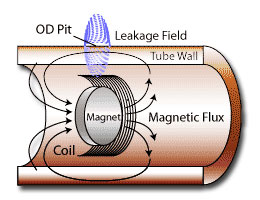Flux Leakage
Magnetic Flux Leakage

Magnetic Flux Leakage (MFL) is used to test highly permeable (magnetic) alloys such as carbon steel. Due to the high permeability of carbon steel eddy current penetration is severely limited, and the detection of subsurface and far surface defects are not detectable with that method.
MFL has been used successfully for many years in the wire rope, petrochemical, and power industries. This test method involves magnetizing the area of the tube under test to a level approaching saturation. This is done with high energy permanent magnets and circuitry mounted in the inspection probe. The probe is inserted the full length of the tube and retracted at a constant speed to obtain the test results.
Defects with abrupt boundaries such as pits or cracks produce a leakage field which rises above both the inside and outside surface of the tube. Inside the probe head are detection coils, in which a voltage is produced as they pass through a leakage field. For damage such as gradual wall loss or bulges where a leakage field wouldn’t be produced. A Hall Effect sensor is used to detect changes in the flux density produced by the magnet.
The inspection results are in the form of amplitude spikes. These spikes are compared to the indications produced by milled notches in a calibration reference standard of the same diameter, wall thickness and alloy.
The severity of damage is determined by its response as compared to the response of a simulated defects on the calibration reference standard. However, the response caused by natural damage may differ from the response caused by artificial notches and grooves.
TAI uses probes with a minimum fill factor of .80 and we can inspect tube diameters from 1/2" to 3". Other probe sizes can be made if needed.
